One of a kinds...
Reprinted from "Crown Jewels of the Wire", May 2005, page 20
For over a year Butch and Eloise Haltman (below) invited Linda and I to come
to their home to photograph their insulator collection, particularly their
one-of-a-kind
pieces. We finally made the trip this past winter, thoroughly enjoying their
hospitality. Our feature article this month is about those unique insulators in
the Haltman's collection.
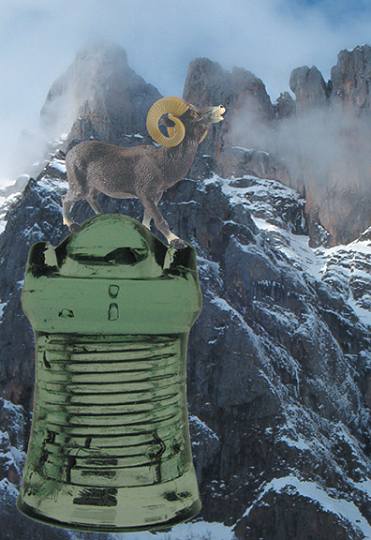

How is it that only a single example of a particular insulator can remain in
the hobby? In some cases it is possible that only a single example was created
for submission with the patent application for that design. In some cases, the
insulator's unique features weren't practical for commercial production, and
only a few... maybe only one... example was ever made. It may also be that
additional examples do exist, but simply haven't been reported. I firmly believe
that may be true of the CD 250 (see story on page 34). Perhaps this article will
result in new discoveries? But, you ask, what about the artistic presentation
this month? Well... turn to the next page.
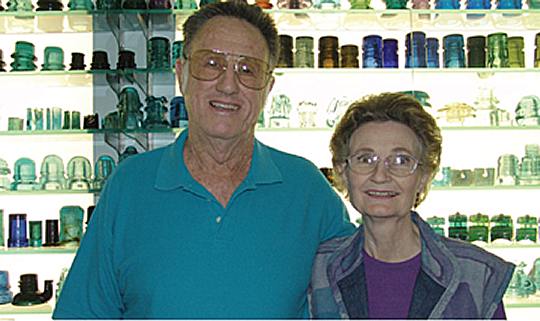
(pg. 21)
Unique Insulators
Insulators featured on various color pages from page 22 through 44, as well
as on the front cover, inside the front cover, and inside the back cover, are
all "one of a kind" items. "One of a kind" is in parenthesis
for a couple of reasons. In some cases, additional examples are known in broken
or specimen condition. In at least one instance, an additional example was once
known to the hobby but it is currently "missing". And, potentially, a
Crown Jewels reader may own a particular piece and not be aware that it is
something special.
Why the Artistic Presentation?
Since returning from school in Switzerland right after Christmas, our son
David has been doing much of the photo-editing for Crown Jewels. Not long back
he stated that just showing insulators by themselves was "boring".
Oh... the blasphemy! I'm one of those folks that just love to admire the beauty
of an insulator presented all by itself, such as those on the cover of the
February or April 2005 issues of the magazine.
But that just wasn't challenging enough for David. He asked for an
opportunity to do something extra in the presentation. I yielded to this digital
artist, saying he could use his imagination in this feature on "One of a
Kinds". I did lay down two basic ground rules. He could not alter either
the shape or the color of the insulator. David agreed. You'll see his
creativity; and I'll describe the insulators page by page.
CD 109.9 "Ram's Head" - Page 20
This appears to be a "no tie" style of pony insulator. In the last
decade of the 19th Century and the first decade of the 20th, numerous "no
tie" insulator styles emerged. To save money on construction costs,
inventors thought they could patent insulators that would be faster to place in
service. Save a minute or so on each insulator placed in service, while building
telephone leads dozens or even hundreds of miles long, and construction costs
could be reduced significantly. A number of "no tie" designs were
attempted, including these CD's: 109.5, 134.6, 139, 141.7, 141.8, 206.5 and many
others. Few were commercially successful. As a result, some "no ties"
are among the rarest insulators known in the hobby.
The "ram's head" receives its nickname from the shape of the dome,
which resembles the curved horns of a ram sheep. This only known example is
marked vertically on the skirt, "PAT. / APL'D FOR. The color is light
green.
Butch says the "ram's head" was a "walk in" at one of the
Auburn, CA bottle & insulator shows. Shows are held in Auburn each August
and December. The winter event is particularly well attended. And the shows are
famous for insulators that non-collectors bring in to sell, including on one
occasion a CD 130.2 Seiler's Patent and this "ram's head" on another.
(pg. 22)
CD 176.9 "Mushroom" - Page 24
CD 176 styles are nicknamed "mushrooms" because of their shapes.
The CD 176 Whitall Tatums are among the rarest "clear" glass
insulators. Reportedly, some were found on a railroad line across the Bonneville
Salt Flats of Utah. I kick myself every time I hear that story, as I walked
along that railroad in 1967 picking up CD 321's that had been discarded from an
adjacent and abandoned power line. Unfortunately, back then we didn't pay much
attention to clear glass.
The aqua 176.9's are Hemingray products, as identified by an "H" in
a square that is embossed on the dome. It's our understanding these were found
at the Hemingray dump.
Butch says his insulator, shown on page 24, is the same as a 176.9 except
that it is smaller in size. It, too, has the Hemingray logo of an "H"
embossed in a square on the dome.
CD 791 "Baby Tea Pot" - Page 25
The CD 791 shown on page 25 is NOT a "one of a kind". There are all
of four known. Still, it is such a neat insulator we decided to present it in
this article. The nickname "tea pot" is obvious from the shape. It's
called a "baby" because the overall size is about an inch narrower
than the CD 790 tea pots, which are also scarce insulators.
CD 790's and 791's date from the Civil War era or before. Collectors
speculate the "spout" allowed telegraph wire to be placed in service
without having to take the time to tie the wire to the insulator. When rushing
to construct telegraph lines in a war zone, as depicted in the Harper's Weekly
newspaper from 1863, not having to take the time to tie the wire to the
insulators would have been advantageous.
But the speculation could just be collector folk lore. I've had collectors
tell me teapot styles have been found where telegraph lines crossed rivers, as
if that style of insulator was used on each side of a stream to somehow help
with the long span of wire.
We admit that David's placement of the "baby tea pot" with a
backdrop from Harper's Weekly may further a myth about the use of the insulator
without any factual evidence.
"Baby tea pots" are found in dark green and in root beer amber. The
larger tea pots are known in bubbly dark green, dark green, dark teal green,
green, and olive amber blackglass.
Folk lore or not, both styles of tea pots are desirable and historic
collectibles.
(pg. 23)
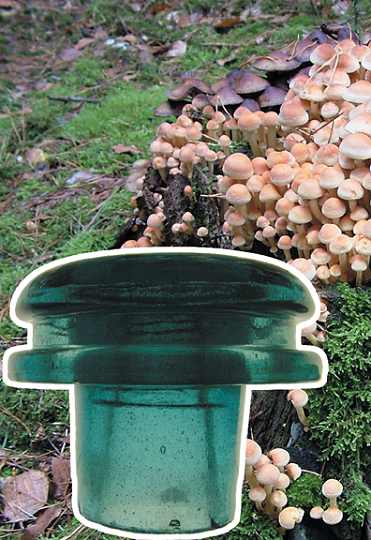
(pg. 24)
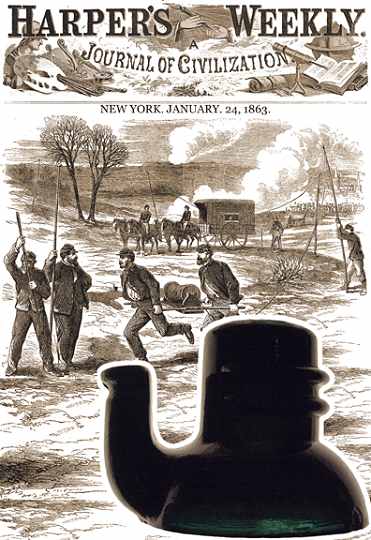
(pg. 25)
CD 309 & CD 309.5 High Tension Insulators - Pages 28 & 29
The insulators shown on pages 28 & 29 are unique not only in the fact
that only one of each is known, but also in their unusual shape. According to
"A History and Guide to North American Glass Pintype Insulators" by
John & Carol McDougald (1990), "Carroll N. Beal of San Francisco,
California was issued a patent on October 10, 1899. The insulator covered in the
patent, CD 309 (page 29) was designed to be mounted below the crossarm which
would protect the conducting surface of the insulator from rain and snow. The
design also had two triangular-shaped flanges on each of the insulator body
which paralleled the line wire, forcing water to be shed outward and away from
the line wire. The flanges served as "umbrellas" for the line wire.
"Although Beal's patent drawing shows several types of installation
(line engravings shown on both pages 28 & 29), CD 309 has a pinhole with
standard threading." Figure three matches the actual design of the 309.
Both are pictured on page 29.
The CD 309 is embossed Beal's High Tension I Insulator (top of left ear) and
Patented October 10,1899 (top of right ear). The CD 309 measures 7 inches wide
by five and 7/8ths inches long.
By contrast, the CD 309.5 (page 28) is 7.5 inches wide by 10 inches long. It
is embossed Westinghouse Electric & M'F'G Co. / Pittsburg, PA (front skirt)
and "Telluride" Type B on the reverse side.
McDougald's book states, "This insulator is similar to the design of the
Beal's Patent (CD 309) since it is an insulator to be mounted to the underside
of the crossarm. It has a double petticoat and no transverse wire groove on the
crown or it might resemble a November 12, 1901 patent issued to Ralph
Hemingray."
For presentation purposes, our son edited Beal's patent drawings around both
insulators. The actual Hemingray patent drawing which most closely matches the
CD 309.5 (page 28) is presented on the opposite page. Credit for Hemingray
patent drawing also goes to the McDougald's book, which itself gave credit to
Hemingray historian David Dale.
I find it interesting to note that the patent applications seem to have
placed an emphasis on the insulator being mounted under the arm to protect
against rain and moisture. These both strongly resemble suspension insulators,
and the CD 309 is even embossed "High Tension Insulator". It really
appears as if these were intended to be suspensions. However, mounting a
suspension insulator to hold thousands of pounds of wire over wide spans under a
cross arm via a threaded pin would obviously not meet with desired results.
Were these the forerunners of porcelain and/or glass suspension insulators
that rose to prominence by the World War One era? Has anyone studied whether
early suspension insulators were used around Telluride, Colorado?
(pg. 26)
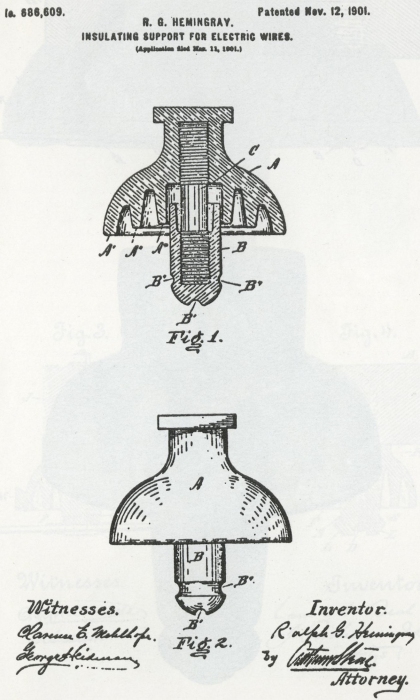
(pg. 27)
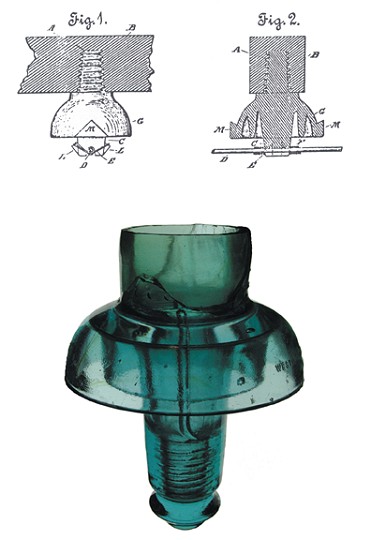
(pg. 28)
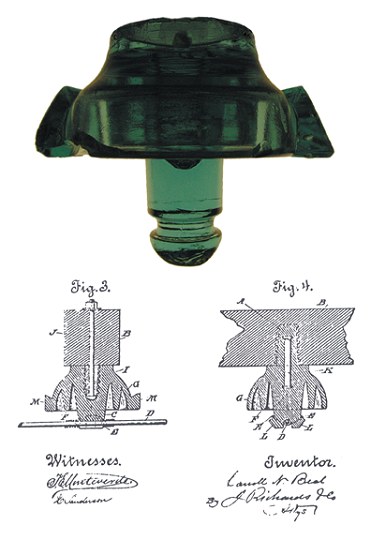
(pg. 29)
More "Oneofa's"
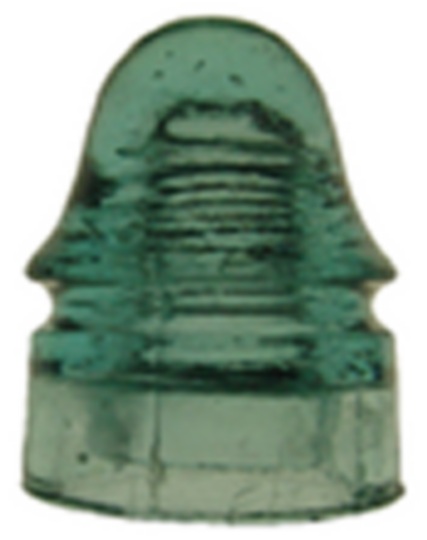 |
CD 160.4
Not all one-of-a-kinds are found in unusual shapes. To the left is a CD 160
style "baby signal". It's an American Insulator Company product, and
listed in the price guide as a CD 160.4. Except, there's a major difference from
the one listed in the price guide. This one is unembossed.
Butch Haltman says no other unembossed examples have been reported. The color
is aqua.
|
CD 174.5
The name is Pyrex. The color is clear. But the insulator shown below is not
your common insulator. This is a Pyrex 660 with a 1919 Patent Date. While a
couple of CD 174.5's are known to exist, Butch's example is slightly different
shaped than the other. The crown on Butch's has squared sides, while the other
one is rounded.
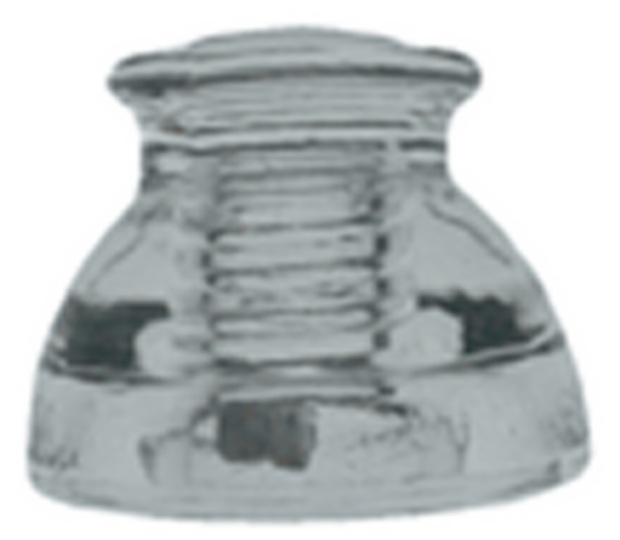
(pg. 30)
Insulator Postage Stamps
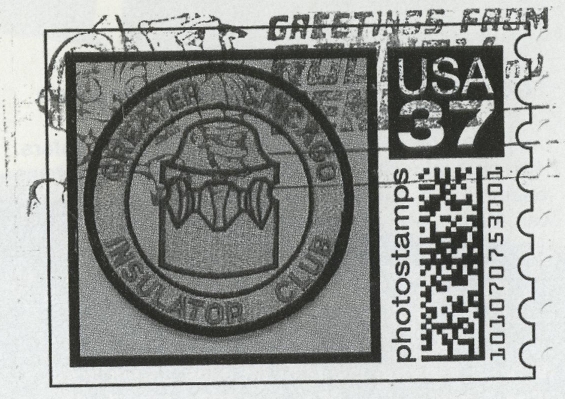
The postage stamp above, featuring a CD 135 Chicago Diamond Groove insulator,
is made by the Greater Chicago Insulator Club for use in mailing its
newsletters. Our son, David, based his concept for an insulator postage stamp
(page 33) on the recent US Postal Service series featuring light houses.
|
CD 724.6
The only known example of a CD 724.6 threadless is this broken specimen. Only
the dome and a part of the skirt remain. Early threadless insulators are
difficult to find in any condition, but there remains a possibility someone may
someday dig another example of this CD.
|
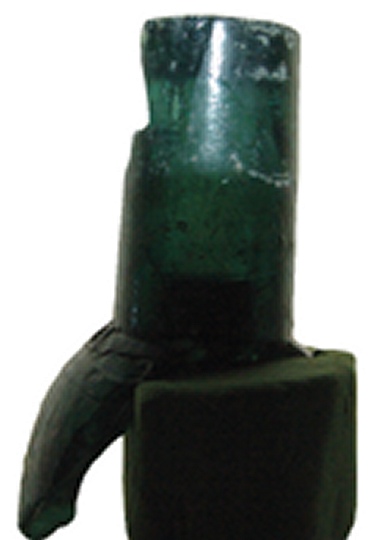 |
(pg. 31)
CD 207.5 - Searching Out Something New
Until 2001, no one had ever seen a CD 207.5 before. This exceptionally
unusual insulator, while perhaps resembling a couple of porcelain insulator
patents, was
a completely unknown design in glass.
Then a Canadian couple found one in clear glass at a flea / antique market.
They paid the grand sum of $5.00 (Canadian).
Within a year the insulator on page 33 surfaced. In aqua glass, it's also a
one-of-a-kind as no additional examples in any color have been reported.
Are there more of these waiting to be found? Maybe it's time to check out
your local antique shops once again.
(pg. 32)
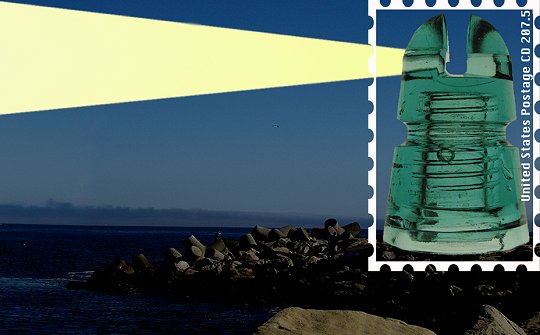
(pg. 33)
Where's the Beef? - Page 36
So what's the big mystery about a rather ordinary looking N.E.G.M. cable
insulator? Well, first, this insulator is a CD 250. It doesn't have an inner
skirt like the CD 251's. Second, there's only one known. Presently. A second
example known to the hobby decades ago has disappeared.
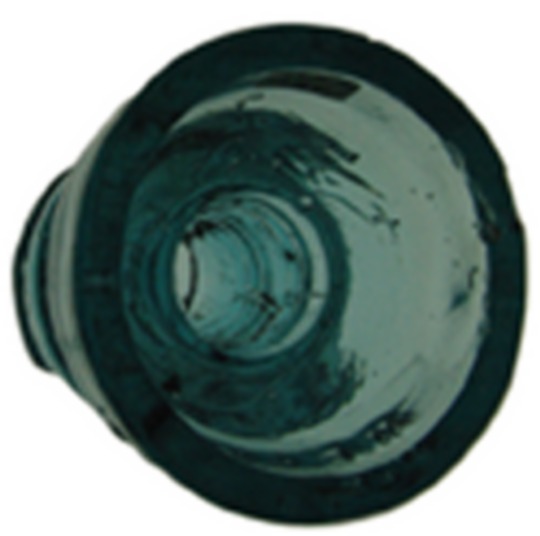
Butch purchased this odd ball CD from a well respected collector who took it
off a line himself... in the 1950's. It's provenance is undisputed. But,
somewhere out there, at least one more example lurks.
The story of the second insulator dates to 1967. A collector named Chuck Fox
was building a collection by trading off insulators he had found. I was at
Chuck's house in Glendale, Oregon one day when he received a package in the mail
from a collector he had traded with. In the box were three insulators.... all
cable tops like the CD 251's. Except that Chuck noticed right away one was
different. It didn't have an inner skirt. It was the now missing CD 250.
Chuck knew there was something special about the insulator, since he was
never able to personally locate another example at a show or in a collection.
Around 1972 Chuck traded off his insulator collection for an antique automobile.
Chuck died in the 1990's. Just a couple of years ago I was contacted by his
widow, who shocked me by saying Chuck didn't get rid of his best insulators. She
didn't know where they were, but she was planning to move and would likely be
finding the box they were packed away in. However, she was unable to find the
box.
Intrigued by her information, I conducted a search on the internet for the
man who received the bulk of the insulators from Chuck in the trade for the car.
I was successful in the search. But when I questioned the man about several of
the key insulators from Chuck's collection, including the CD 250, the man stated
he never owned any of them. They didn't come in the trade.
What happened to the box of insulators Chuck's wife remembered but could not
find? She now suspects it may have been auctioned when Chuck's collection of
automobile parts were sold after his death. Somewhere out there, in some car
collectors garage or museum, there's a box of insulators wrapped in newspapers
dated 1972. In that wrapping, someone may someday find an E-Mold CD 123 EC&M
(upside down embossing), an 1871 dated CD 134 in peacock blue, an amber CD 134
T-H E, the CD 250, and a handful of other crown jewels of equal caliber.
(pg. 34)
Hemingray CD 317.7 - Page 37
I certainly do wish Linda was good enough at shadow art to make Hemingray CD
317.7's appear!
It might be the only way another example will ever be found. This is another
unique Hemingray product. It's embossed H.G. CO. / PATENT MAY 2, 1893. Yes,
there are drip points... but only on the inner skirt.
The Spaceman - Alien to All Insulators See pages 40-41.
Cherry Picking Insulators - CD 286.9 - Page 44
Insulators grown on trees? Now my first ever job was picking cherries. But I
never saw any as delicious looking as these aqua jewels. The fruit of David's
work in this picture are CD 286.9's. Well, maybe his picture shows one more than
actually exists. This insulator is embossed: WESTINGHOUSE ELECTRIC & M'F'G
CO. / PITTSBURG, PA (front skirt) and "TELLURIDE" TYPE C (rear skirt).
Is this another experimental suspension type insulator? And there's yet another
reference to Telluride, the famous Colorado mining town. Hmm!
Insulator Candle - CD 786 - FRONT COVER
Insulators have commonly been turned upside down and used as candle holders.
But the CD 786 looks like a candle itself, at least in David's presentation. The
insulator is also unusual for a threadless in that it is made of clear glass.
Thumb through the entire CD 700 series, or CD 1000 series, and you'll be hard
pressed to find more than a couple other clear insulators from the historic
early period of insulator production.
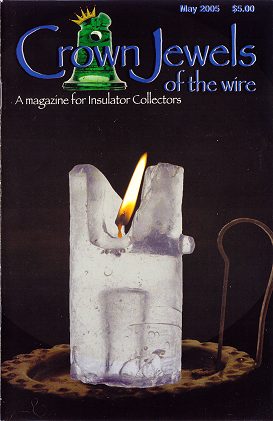
(front cover)
CD 1038 Cutter - INSIDE BACK COVER
Most Cutter tree insulators have a ribbed base. A smaller number have a
hollow base that collectors have nicknamed "coffin bottoms". And
there's this unique Cutter. The base projects outward, leading collectors to
call it a "reverse coffin bottom". Don't bury this item too deep in
your mind. Butch Haltman says it's a one of a kind. R.I.P. in this case means...
"Remember Insulator Projects". Can anyone else resurrect one?
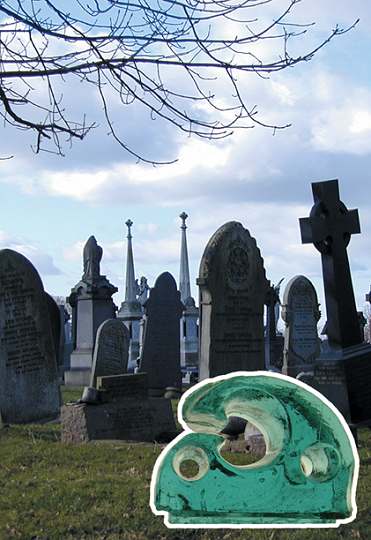
(inside back cover)
Final Notes:
We hope you enjoyed this month's presentation of one-of-a-kinds. Other
collectors also have some one-of-a's they'd like to show off. If you have one,
let us know as we will do a follow-up feature in a month or two. Thanks to Butch
& Eloise for allowing us to photograph their insulators. Thanks to the John
and Carol McDougald for continuing to allow us to use their books as references.
Thanks to Tommy Bolack for his grant to pay for the color printing in Crown
Jewels. And thanks to David Banks for sharing his imagination with us.
(pg. 35)
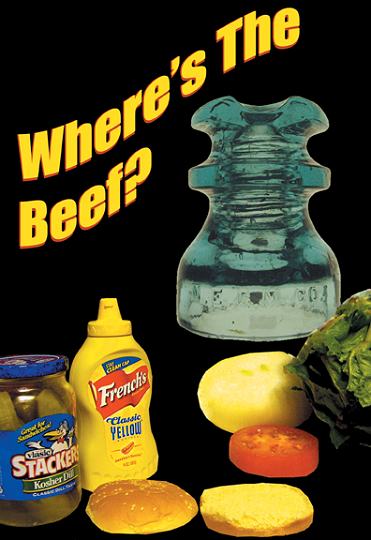
(pg. 36)
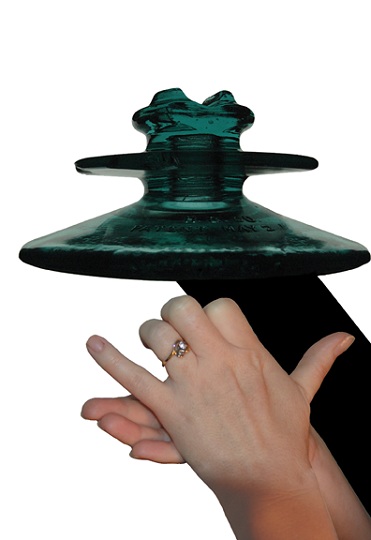
(pg. 37)
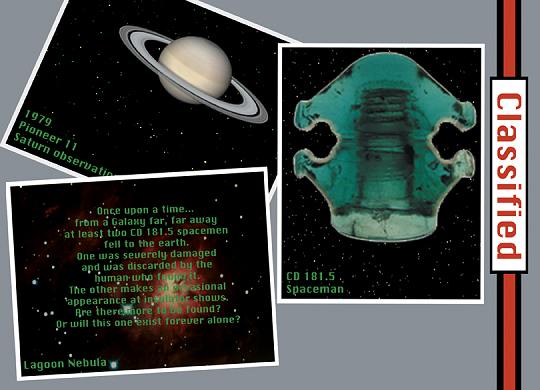
(pg. 40, 41)
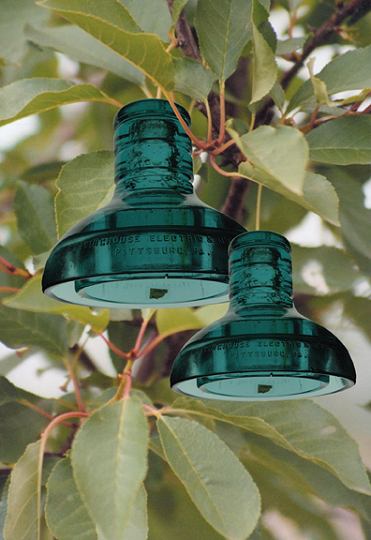
(pg. 44)
| 